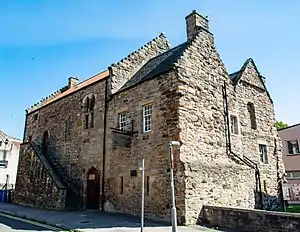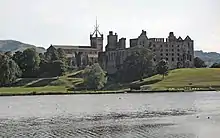Ellen More
Ellen or Elen More (fl. c. 1500–1535) was an African servant at the Scottish court.



.jpg.webp)

Career
Ellen More was employed in Edinburgh Castle in the household of Lady Margaret, the daughter of James IV of Scotland and his mistress Margaret Drummond.[1] Ellen More was later an attendant of Margaret Tudor at Linlithgow Palace.[2]
The name "More" recorded in the Scottish accounts seems to be from the word "moor", meaning an African person.[3] The reign of James IV (1488 to 1513) coincided with the era of Portuguese exploration which established firm contact between Europe and Africa. James licensed Scottish privateers like Andrew Barton to attack Portuguese shipping.[4] This may have provided a potential route for African people to reach Scotland, although there is no direct evidence of this. Archival references to the "Moorish lasses" were re-discovered by William MacGregor Stirling (1771-1833) and the privateer connection was suggested by Patrick Fraser Tytler.[5] The accounts of the treasurer and comptroller of Scotland record the employment of Africans at the court of James IV.[6]
In October 1504 Margaret Tudor was at Dunfermline Palace, across the Forth from Edinburgh in Fife. James IV was in the north at Elgin. There was a suspected outbreak of plague at Dunfermline.[7] Four African women, called "More lasses", went to North Queensferry and Inverkeithing on 8 November, looked after by the court apothecary, John Mosman. They went on to Edinburgh. The accounts record that a woman "tursit" the "More lasses" from Dunfermline, a word that usually means the packing and transport of household goods with cord but can also mean the transport of people.[8]
James IV arrived in Edinburgh, and came to Holyrood Palace by 18 November, where on 22 November he rewarded a man who had brought animals with 20 gold crowns, these animals had been with the African women, the "More lasses", at Inverkeithing. They included a Portuguese horse with a red tail, and a civet or "must cat". On 26 November he gave the woman who brought the "More lasses" from Fife 4 shillings. On 27 November James IV ordered that two suspected plague victims, who had been excluded from Dunfermline town, should have 14 shillings.[9][10][11][12]
At first the four Africans, recorded as "Ethiopians", were lodged in the house of James Hommyll, a wealthy Edinburgh merchant who bought tapestries for the king. Hommyll also hosted the Portuguese man who was escorting the African people, who had brought them to Scotland.[13] The king had sent his brother, William Hommyll, on an errand to Portugal in December 1503.[14]
One "More las" was christened on 11 December 1504, and probably given a new name.[15] In July 1505 a Leith mariner and timber merchant William Wod received a reward of £12 Scots from the king for carrying the African people to the court at Stirling Castle accompanied by the horse from Portugal, a jennet horse, and a must cat, or perhaps for bringing the African people and the animals to the Scottish court. It remains unclear if the mariner Wod had brought the Africans and the Portuguese man to Scotland from a ship he captured under "letters of Marque" or whether the King had requested him to obtain the African people to be his servants.[16] The apothecary Mosman came to Stirling on 6 November to fetch the must cat.[17]
These records may refer to the arrival of Ellen and her sister Margaret. Ellen and Margaret seem to be the two "More lassis" at Edinburgh Castle who attended Lady Margaret and were bought shoes.[18] The shoemaker was John Davidson, who also made shoes for the Danish noble, Christopher or Christiern, said to be a son of Elizabeth of Denmark.[19] In 1506 they were both given gowns of russet cloth with velvet bands, with red skirts or kirtles. In 1507 they, and another girl in the castle, Marjory Lindsay, were given red skirts with green ribbons.[20]
In later years they joined the court of Margaret Tudor and were bought clothes, and given New Year's day gifts, comparable to those given to the queen's English lady in waiting, Mistress Agnes Musgrave. Ellen is known to have worked for the queen at Linlithgow Palace.[21] This is an example from the accounts of a New Year gift of money, five French gold crowns worth £3-10s Scots, given to Ellen More on 1 January 1512; "Item, to Elene Moire, v Franch crounis, iij li x s."[22] She had been given her livery clothes, an allowance of clothing given to many royal servants in the days before Christmas, on 15 December 1511. This included a gown made of "Rissillis broun" (russet cloth from Rijsel or Lille) trimmed with velvet, with yellow taffeta sleeves, a velvet hood, and skirt of English brown or russet woollen cloth with a crimson hem.[23] Margaret More is mentioned less often in the accounts, but she was at Linlithgow Palace in April 1512, when James V of Scotland was born. The "two black ladies" were given 10 gold crowns on 1 January 1513.[24]
The king's daughter, Lady Margaret Stewart married John Gordon, Lord Gordon and then Sir John Drummond of Innerpeffray.[25]
Ellen More was given 40 shillings in July 1527, recorded as a payment to "Helenor, the blak moir".[26] No further details of the lives of Ellen and Margaret More are known for certain.
It may be that one "Margaret Prestoun", an attendant of Margaret, Lady Gordon who rode north with her and John Sinclair over the Mounth towards Huntly Castle on 19 November 1512, was the same person as Margaret More.[27] Lady Gordon's place at court was taken by her half-sister, also Margaret Stewart, a daughter of Janet Kennedy summoned from Darnaway in April 1513.[28]
Of Ane Blak-Moir
William Dunbar wrote a poem for the court of James IV with the title Of Ane Blak-Moir which describes the appearance of a black woman involved in a tournament in unflattering and racist terms.[29] James IV staged two elaborate tournaments called "The justing of the wyld knicht for the blak lady", held in June 1507 and again in May 1508. The part of the "Black Lady" was played by a woman of the court. It is not clear if William Dunbar's poem was connected to these events, or that Ellen More played the part of the Black Lady in the tournaments, although the identity of Ellen, or Elen More, is discussed in scholarship as the subject of Dunbar's poem, the woman named in the accounts, and the actor in the tournaments.[30]
The Black Lady Tournaments
The expenditure on these lavish events, imitating the "round table of King Arthur of England", was recorded in the treasurer's accounts, and the tournaments were described in Scottish chronicles.[31] The invitation to the tournament sent to France was illuminated with gold leaf.[32] It was issued by the Marchmont Herald on behalf of the 'Chevalier Sauvage à la Dame Noire', the Wild Knight to the Black Lady, and gave details of the events to be held at Edinburgh.[33]
The Black Lady's gown was made from Flanders damask figured with gold flowers, bordered with yellow and green taffeta, with outer sleeves of black gauze, inner sleeves, a drape of the same black gauze about her shoulders and arms, and she wore long gloves of black chamois or "semys" leather.[34][35]
In 1508 the costume was renewed with a green woollen skirt, and new black leather sleeves and gloves.[36] William Ogilvy and Alexander Elphinstone, possibly Alexander Elphinstone, 1st Lord Elphinstone, dressed in white damask as the "Squires of the Black Lady" and escorted her from Edinburgh Castle to the field of the tournament.[37] Antoine d'Arces was the "White Knight". James IV himself played the part of the Wild or Savage Knight.[38][39] At the end of the three-day event, at the concluding banquet, a cloud descended from the roof of the Hall and swept away the Black Lady.[40][41]
Representation in Media
Ellen More is featured in a short animation titled The Tournament of the African Lady[42] which also depicts John Blanke, a trumpeter at the English court, written and directed by Jason Young.[43]
Africans represented in court drama
In 1504 and 1505 James IV employed an African drummer known as the "More taubronar." James IV travelled with him and four Italian minstrels on his trip to the north to Darnaway and Elgin. The drummer devised a masque or dance for the tournament held on Shrove-Tide, called "Fasterins Eve". Twelve dancers wore costumes in black and white fabrics.[44] The "taubronar" was paid a fee of the same value as that paid to another drummer, Guilliam, and to Margaret Tudor's attendant Mistress Elizabeth Barley, who later married Lord Elphinstone.[45]
Later Stewart court festivities and drama with African actors and actors portraying Africans, include; the baptism of James VI at Stirling in December 1566,[46] the Entry of Anne of Denmark to Edinburgh (1590), the baptism of Prince Henry (1594), and The Masque of Blackness (1605).[47][48] Clare McManus identifies "markers of difference, foreigness and liminality" and "compact symbols of blackness and femininity initially encapsulated in the body of the Black Lady" of James IV's tournaments which reappeared at the baptism of Prince Henry, and were suited to Scottish conventions of court theatre and performance.[49]
At the court of Edward VI of England actors in masques were dressed as "Mores" with long black velvet gloves reaching above the elbow, with bells attached to costumes made from goat's skins.[50] A contemporary description of the 1590 event distinguished between townspeople who had blackened their faces, and "an absolutely real and native blackamoor."[51]
External links
- Onyeka Nubia, 'Africans in England and Scotland, 1485–1625', Oxford Dictionary of National Biography (10 October 2019). Retrieved 5 November 2020, subscription or UK public library membership required
- Miranda Kaufmann, 'Africans in Britain, 1500-1640', University of Oxford, PhD thesis, 2011, see pp. 43-4, 64, 193, 197-8, Appendix, table 5
- Minjie Su, 'Elen More: The Moorish Lass in James IV’s Court', Medievalists.net.
- Mairi Cowan, 'Moors at the Court of James IV, King of Scots', Medievalists.net.
- Bess Rhodes, Edinburgh Castle Research: The Tournaments (Historic Environment Scotland, 2019).
- Lesley Mickel, 'Blackness and Wildness: James IV and Highland Cultural Identity'.
- Arkady Hodge, Edinburgh Castle Research: The Medieval Documents (Historic Environment Scotland, 2019).
- 'The King’s Daughter and the "Moorish Lassies"', Historic Environment Scotland blog
- Paul Edwards, 'Early African Presence', Occasional Papers, no. 26 (Edinburgh, 1990)
- Jennifer Melville, 'Africans at the court of James IV', National Trust for Scotland
References
- Mary E. Robbins, 'Black Africans at the Court of James IV', Review of Scottish Culture, 12 (1999), pp. 34–45: James Balfour Paul, Accounts of the Treasurer of Scotland, vol. 3 (Edinburgh, 1901), pp. lxxxv, 182.
- Accounts of the Treasurer of Scotland, vol. 4 (Edinburgh, 1902), pp. 232, 324, 404, 434: Miranda Kaufmann, Black Tudors (London, 2017), pp. 17-18: Sue Niebrzydowski, 'The Sultana and her Sisters: Black Women in the British Isles before 1530', Women's History Review, 10:2 (2001), pp. 187-210, 201-205: Imtiaz Habib, Black Lives in the English Archives, 1500-1677: Imprints of the Invisible (Ashgate, 2008), pp. 31-7, 292-3.
- Nubia, O., (2019, October 10), 'Africans in England and Scotland (1485–1625)', Oxford Dictionary of National Biography.
- Norman Macdougall, James IV (Tuckwell: East Linton, 1997), p. 239: Steve Murdoch, Scotland's Maritime Warfare (Brill, 2010), p. 81: Robert Kerr Hannay, Letters of James IV (SHS: Edinburgh, 1953), pp. 81-2 no. 125: Robert Kerr Hannay & Denys Hay, Letters of James V (Edinburgh, 1954), p. 401.
- Patrick Fraser Tytler, History of Scotland, vol. 5 (Edinburgh, 1834), pp. 43-4, and see P. F. Tytler, Lives of Scottish Worthies, vol. 3 (London, 1833), p. 331 MacGregor's publications include Notes, Historical and Descriptive, on the Priory of Inchmahome (Edinburgh, 1815). His son Robert MacGregor Stirling emigrated to Jamaica.
- George Burnett, Exchequer Rolls: 1502-1507, vol. 12 (Edinburgh, 1889), pp. 374-5 (Latin)
- Accounts of the Treasurer of Scotland: 1500-1504, vol. 2 (Edinburgh, 1900), pp. 462-3, James IV had travelled with four Italian minstrels and an African drummer.
- Accounts of the Treasurer of Scotland, vol. 2 (Edinburgh, 1900), pp. 465, 468: 'Turs, v. 3', Dictionary of the Scots Language: Dictionar o the Scots Leid.
- Accounts of the Treasurer of Scotland, vol. 2 (Edinburgh, 1900), pp. 465, 468.
- W. J. MacLennan, 'The Eleven Plagues of Edinburgh', Proceedings of the Royal College of Physicians of Edinburgh, 31:3 (2001), p. 257, summary of the 1505 plague regulations for Edinburgh
- J. F. D. Shrewsbury, A History of Bubonic Plague in the British Isles (Cambridge, 1970), p. 165.
- Richard Oram, '"It cannot he decernit quha are clean and quha are foulle.": Responses to Epidemic Disease in Sixteenth- and Seventeenth-Century Scotland', Renaissance and Reformation / Renaissance et Réforme, 30:4 (Fall / Automne 2006 / 2007), pp. 13-39, p. 16.
- George Burnett, Exchequer Rolls of Scotland: 1502-1507, vol. 12 (Edinburgh, 1889), pp. 374-5 (Latin), the Africans were lodged with Hommyll "extra domicilium", indicating that they were members of the royal household staying elsewhere.
- Accounts of the Treasurer, vol. 2 (Edinburgh, 1900), p. 409.
- Accounts of the Treasurer, vol. 2 (Edinburgh, 1900), pp. cx, 465, 468, 469, 470: Accounts of the Treasurer, vol. 3 (Edinburgh, 1901), p. 148: Exchequer Rolls, vol. 12 (Edinburgh, 1889), pp. 374-5: Habib, Black Lives, p. 31.
- Accounts of the Treasurer: 1506-1507, vol. 3 (Edinburgh, 1901), p. 148, this payment is usually interpreted as payment for bringing the animals and African people from Portugal.
- Accounts of the Treasurer: 1506-1507, vol. 3 (Edinburgh, 1901), p. 169.
- Laura E. Walkling & Mairi Cowan, 'A 'gret cradil of stait': Growing Up with the Court of James IV', Janay Nugent & Elizabeth Ewan, Children and Youth in Premodern Scotland (Boydell, 2015), pp. 15-30.
- Accounts of the Treasurer of Scotland: 1506-1507, vol. 3 (Edinburgh, 1901), pp. xc, 155.
- Accounts of the Treasurer of Scotland: 1506-1507, vol. 3 (Edinburgh, 1901), lxxxv, 114, 155, 172, 175, 310-11, 321-2, 336, 361, 370-1, 387: Accounts of the Treasurer, vol. 4 (Edinburgh, 1902), pp. 51, 59, 61-2, 82, 100, 116.
- Accounts of the Treasurer, vol. 4 (Edinburgh, 1902), pp. 339, 324, 401, 404.
- Accounts of the Lord High Treasurer of Scotland, vol. 4 (Edinburgh, 1902), p. 324.
- Accounts of the Treasurer, vol. 4 (Edinburgh, 1902), p. 232.
- Accounts of the Treasurer of Scotland, vol. 4 (Edinburgh, 1902), pp. 339, 401
- David Malcolm, Genealogical Memoir of the Most Noble and Ancient House of Drummond (Edinburgh, 1808), p. 78.
- Accounts of the Treasurer: 1515-1531, vol. 5 (Edinburgh, 1903), p. 328.
- Accounts of the Treasurer, vol. 4 (Edinburgh, 1902), pp. 398, 427
- Accounts of the Treasurer, vol. 4 (Edinburgh, 1902), p. 409.
- W. A. Craigie, Maitland Folio Manuscript, vol. 1 (Scottish Text Society: Edinburgh, 1919), pp. 416-7: John Small, The Poems of William Dunbar, vol. 2 (Scottish Text Society: Edinburgh, 1893), p. 201: Kim Hall, Things of Darkness: Economies of Race and Gender in Early Modern England (Cornell, 1995), p. 271.
- Joyce Green MacDonald, Women and Race in Early Modern Texts (Cambridge, 2002), pp. 1-7: Jane E. A. Dawson, Scotland Re-formed (Edinburgh, 2007), pp. 79-81: Bernadette Andrea, The Lives of Girls and Women from the Islamic World in Early Modern British Literature and Culture (Toronto, 2017), pp. 22-26: Bernadette Andrea, 'The "Presences of Women" from the Islamic World', Merry E. Wiesner-Hanks, Mapping Gendered Routes and Spaces in the Early Modern World (Routledge, 2016), pp. 294-8.
- Louise Olga Fradenburg, City, Marriage, Tournament: Arts of Rule in Late Medieval Scotland (Wisconsin, 1991), pp. 233-4: Thomas Thomson, The History of Scotland, by John Lesley Bishop of Ross (Edinburgh, 1830), p. 78.
- Accounts of the Treasurer of Scotland, vol. 3 (Edinburgh, 1901), p. 365.
- Marcus Vulson de la Colombière, La Science Heroique (Paris, 1644), pp. 453-457 or La science heroique (Paris, 1669), pp. 491-6
- Accounts of the Treasurer, vol. 3 (Edinburgh, 1901), p. 259.
- 'Semys', Dictionary of the Older Scottish Tongue (up to 1700)
- Accounts of the Treasurer, vol. 4 (Edinburgh, 1902), p. 64
- Accounts of the Treasurer, vol. 3 (Edinburgh, 1901), pp. xlix, 258-259.
- Katie Stevenson, Chivalry and Knighthood in Scotland, 1424-1513 (Boydell: Woodbridge, 2006), pp. 94-7.
- Norman Macdougall, James IV (Tuckwell: East Linton, 1997), pp. 294-5.
- Frank Shuffelton, 'An Imperial Flower: Dunbar's "The Goldyn Targe" and the Court Life of James IV of Scotland', Studies in Philology, 72:2 (April 1975), pp. 193-207, p. 202.
- Lesley Mickel, 'Our Hielandmen': Scots in Court Entertainments at home and abroad 1507–1616', Renaissance Studies, 33:2 (April, 2019), pp. 185-203 at p. 202: Aeneas Mackay, Historie and Cronicles of Scotland, by Robert Lindesay of Pitscottie, vol. 1 (STS: Edinburgh, 1899), p. 244.
- IMDb: The Tournament of the African Lady (2003)
- IMDb: Jason Young
- Accounts of the Treasurer: 1500-1504, vol. 2 (Edinburgh, 1900), pp. 462-6, 477: Miranda Kaufmann, Black Tudors (London, 2017), p. 11.
- Accounts of the Treasurer: 1506-1507, vol. 3 (Edinburgh, 1901), pp. 119-20, 124.
- Charles Thorpe McInnes, Accounts of the Treasurer of Scotland: 1566-1574, vol. 12 (Edinburgh, 1970), pp. 405-6.
- Bernadette Andrea, The Lives of Girls and Women from the Islamic World in Early Modern British Literature and Culture (Toronto, 2017), pp. 106-12.
- Bernadette Andrea, 'Black Skin, The Queen's Masques: Africanist Ambivalence and Feminine Author(ity) in the Masques of "Blackness" and "Beauty"', English Literary Renaissance, 29:2 (Spring 1999), pp. 246-281.
- Clare McManus, Women on the Renaissance stage: Anna of Denmark and Female Masquing in the Stuart Court, 1590-1619 (Manchester, 2002), pp. 84-5.
- Virginia Mason Vaughan, Performing Blackness on English Stages, 1500-1800 (Cambridge, 2005), pp. 27-8: Alfred John Kempe, Loseley Manuscripts (London, 1836), p. 79-80
- David Stevenson, Scotland's Last Royal Wedding (Edinburgh, 1997), p. 109, the original Danish phrase was "men en ret naturlig og inföd Morian var des Anförer."
